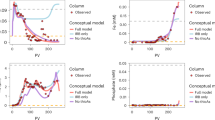Abstract
High concentrations of naturally occurring arsenic are present in alluvial groundwater systems in the midwestern United States. These occurrences tend to be sporadic because the arsenic is mobilized only under a narrow range of redox conditions. The reducing conditions must be sufficient to reduce and dissolve iron and manganese but not to produce sulfide. Typically, the affected aquifers are relatively high in clay content and of relatively low yield. For that reason, many of these arsenic occurrences are in aquifers supplying single families. The mechanism by which the arsenic is mobilized begins with the deposition of iron oxides during streamflow while the alluvium is being deposited. The oxides have a strong affinity for dissolved arsenic and adsorb it from the streamwater. As the alluvium is buried, it eventually becomes subject to slow groundwater movement. As conditions become more reducing, ferric oxides are reduced to soluble ferrous oxides, resulting in mobilization of the adsorbed arsenic.
Similar content being viewed by others
References Cited
Aggett, J., and M. R. Kriegman, 1987, Preservation of arsenic III and arsenic V in samples of sediment interstitial water: Analyst, v. 112, p. 153–157.
Aggett, J., and M. R. Kriegman, 1988, The extent of formation of arsenic (III) in sediment interstitial waters and its release to hypolimnetic waters in Lake Ohakuri: Water Research, v. 4, p. 407–411.
Boyle, R. W., and I. R. Jonasson, 1973, The geochemistry of arsenic and its use as an indicator element in geochemical prospecting: Journal of Geochemical Exploration, v. 2, p. 251–296.
Braman, R. S., and C. C. Foreback, 1973, Methylated forms of arsenic in the environment: Science, v. 182, p. 1247–1249.
Clement, W. H., and S. D. Faust, 1981, The release of arsenic from contaminated sediments and muds: Journal of Environmental Science and Health, v. A16, no. 1, p. 87–122.
Deuel, L. E., and A. R. Swoboda, 1972, Arsenic solubility in a reduced environment: Soil Science Society of America Journal, v. 36, p. 276–278.
EPA (Environmental Protection Agency), 1986, Quality criteria for water: EPA-440/5-86-001, Washington, D.C.
Garland, S. B., A. V. Palumbo, G. W. Strandberg, T. L. Donaldson, L. L. Farr, W. Eng, and C. D. Little, 1989, The use of methanotrophic bacteria for the treatment of groundwater contaminated with trichloroethene at the U.S. Department of Energy Kansas City Plant: ORNL/TM-11084, Oak Ridge National Laboratory, Oak Ridge, TN.
Gulens, J., D. R. Champ, and R. E. Jackson, 1979, Influence of redox environments on the mobility of arsenic in ground water;in E. A. Jenne, ed., Chemical modeling in aqueous systems: Washington, D.C., American Chemical Society.
Holm, T. R., and C. D. Curtiss III, 1988, Arsenic contamination in east-central Illinois ground waters: ILENR/RE-WR-88/16, Illinois Department of Energy and Natural Resources, Springfield, Illinois.
Korte, N., 1990, Naturally occurring arsenic in the groundwater at the Kansas City Plant; ORNL/TM-11663 Oak Ridge National Laboratory, Oak Ridge, TN.
Maiorino, R. M., and H. V. Aposhian, 1985, Dimercaptan metal-binding agents influence the biotransformation of arsenite in the rabbit: Toxicology and Applied Pharmacology, v. 77, p. 240–250.
Matisoff, G. C. J. Khourey, J. F. Hall, A. W. Varnes, and W. H. Strain, 1982, The nature and source of arsenic in northeastern Ohio ground water: Ground Water, v. 20, no. 4, p. 446–456.
Pierce, M. L., and C. B. Moore, 1980, Adsorption of arsenite on amorphous iron hydroxide from dilute aqueous solution: Environmental Science and Technology, v. 14, p. 214–216.
Sonderegger, J. L., and T. Ohguchi, 1988, Irrigation related arsenic contamination of a thin, alluvial aquifer, Madison River Valley, Montana, U.S.A.: Environmental Geology and Water Sciences, v. 11, no. 2, p. 153–161.
Tidball, R. R. 1984. Geochemical survey of Missouri: U.S. Geological Survey Prof. Paper 954-H, I, Washington, D.C.
Thompson, J. M., 1979, Arsenic and fluoride in the upper Madison River System Firehole and Gibbon rivers and their tributaries, Yellowstone National Park, Wyoming, and southeast Montana: U.S. Geological Survey, Menlo Park, CA.
Van Wagenan, S., D. E. Carter, A. G. Ragheb, and Q. Fernando, 1987, Kinetic control of peak shapes in atomic absorption arsenic determinations by arsine generation: Analytical Chemistry, v. 59, no. 6, p. 891–896.
Welch, A. H., M. S. Lico, and J. L. Hughes, 1988, Arsenic in ground water of the western United States: Ground Water v. 26, no. 3, p. 333–347.
Author information
Authors and Affiliations
Additional information
Publication No. 3597, Environmental Sciences Division, ORNL.
Operated by Martin-Marietta Energy Systems for the U.S. Department of Energy under Contract No. DE-AC05-84OR21400.
Rights and permissions
About this article
Cite this article
Korte, N. Naturally occurring arsenic in groundwaters of the midwestern United States. Environ. Geol. Water Sci 18, 137–141 (1991). https://doi.org/10.1007/BF01704667
Issue Date:
DOI: https://doi.org/10.1007/BF01704667




